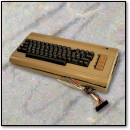[ Retro Scan of the Week ] Benj’s Early Computer Art
Monday, March 31st, 2014As I’ve previously mentioned, I’ve found a wealth of Retro Scan material while looking through old family papers in the attic at my mom’s house.
This time, I was sorting through a giant box of my ancient artwork from school, and I came upon this fascinating computer printout from my kindergarten era (1985-86).
I vaguely remember making it (although, strangely, I mostly remember coloring in those little boxes and being proud of it), but I have no idea what software I used to do it. I know that my school stocked itself with IBM PCs, but the font and the overall feel of the image remind me of an Apple II MECC educational game.
Whatever the platform, this looks like the output from a stamp/clip-art program for kids. Does anybody know what it is?
[ Update: 09/25/2015 – I figured out what game this is. After going through a pile of MECC disks for the Apple II, I ran across one game called Paint With Words (published by M.E.C.C. in 1986). I booted it up on my Apple IIc, and sure enough, it is the program used to create the image in this scan. It is a really neat game that allows you to place words onto a pre-defined background image using a mouse or a keyboard. After you set them in place, the words turn into pictures of what the words represent. My family owned an Apple IIc circa 1984-1987, so I believe this printout was created at home. ]
Discussion Topic of the Week: What was the first computer paint program you ever used?















